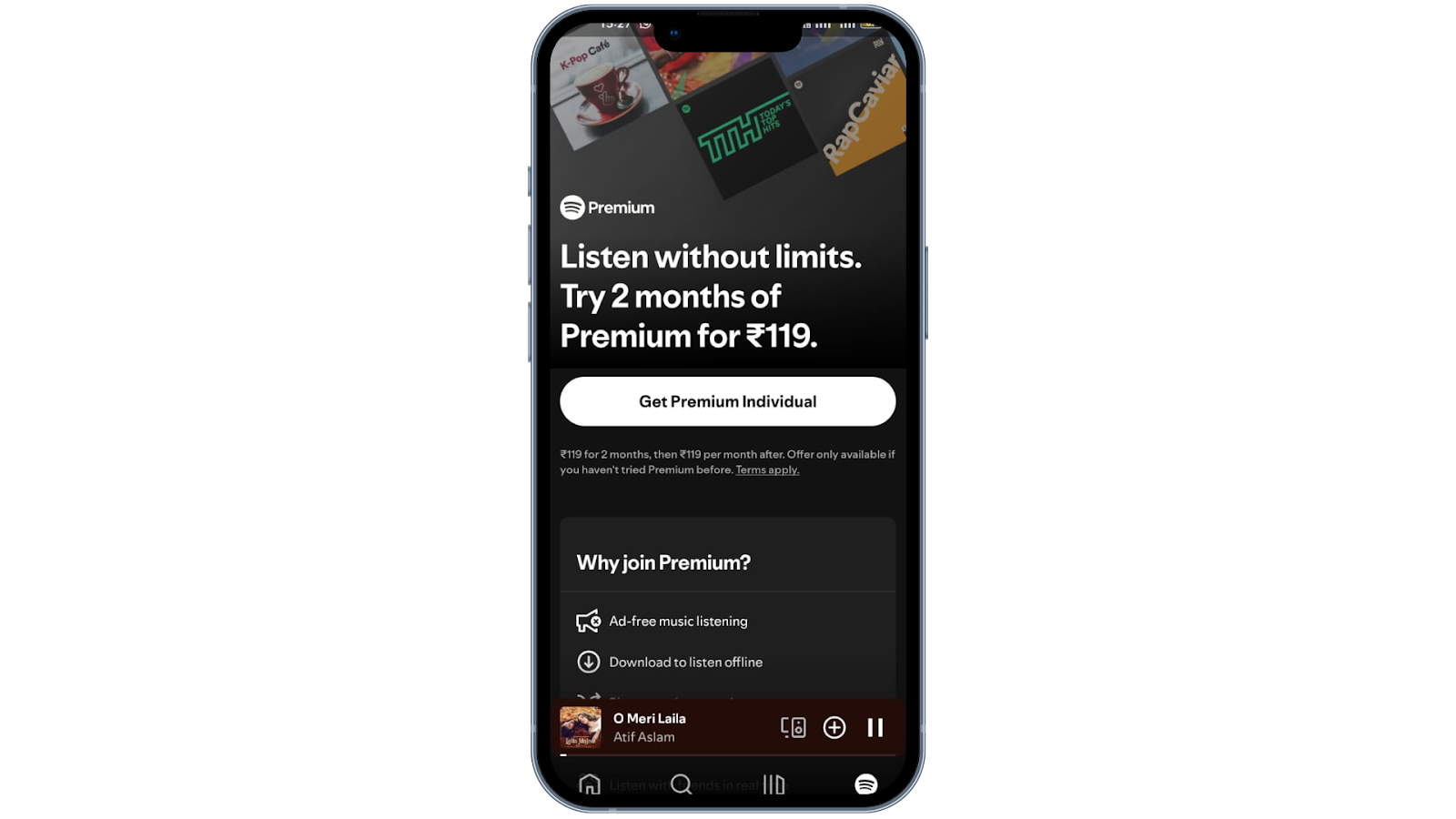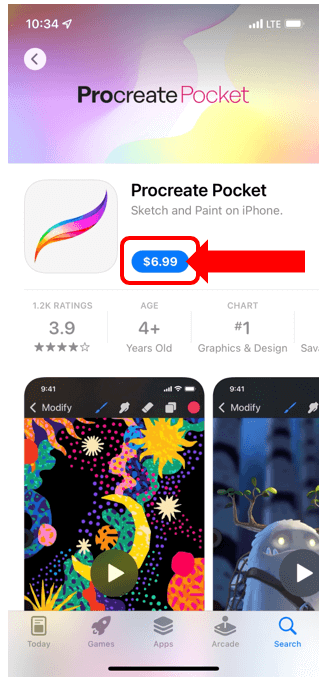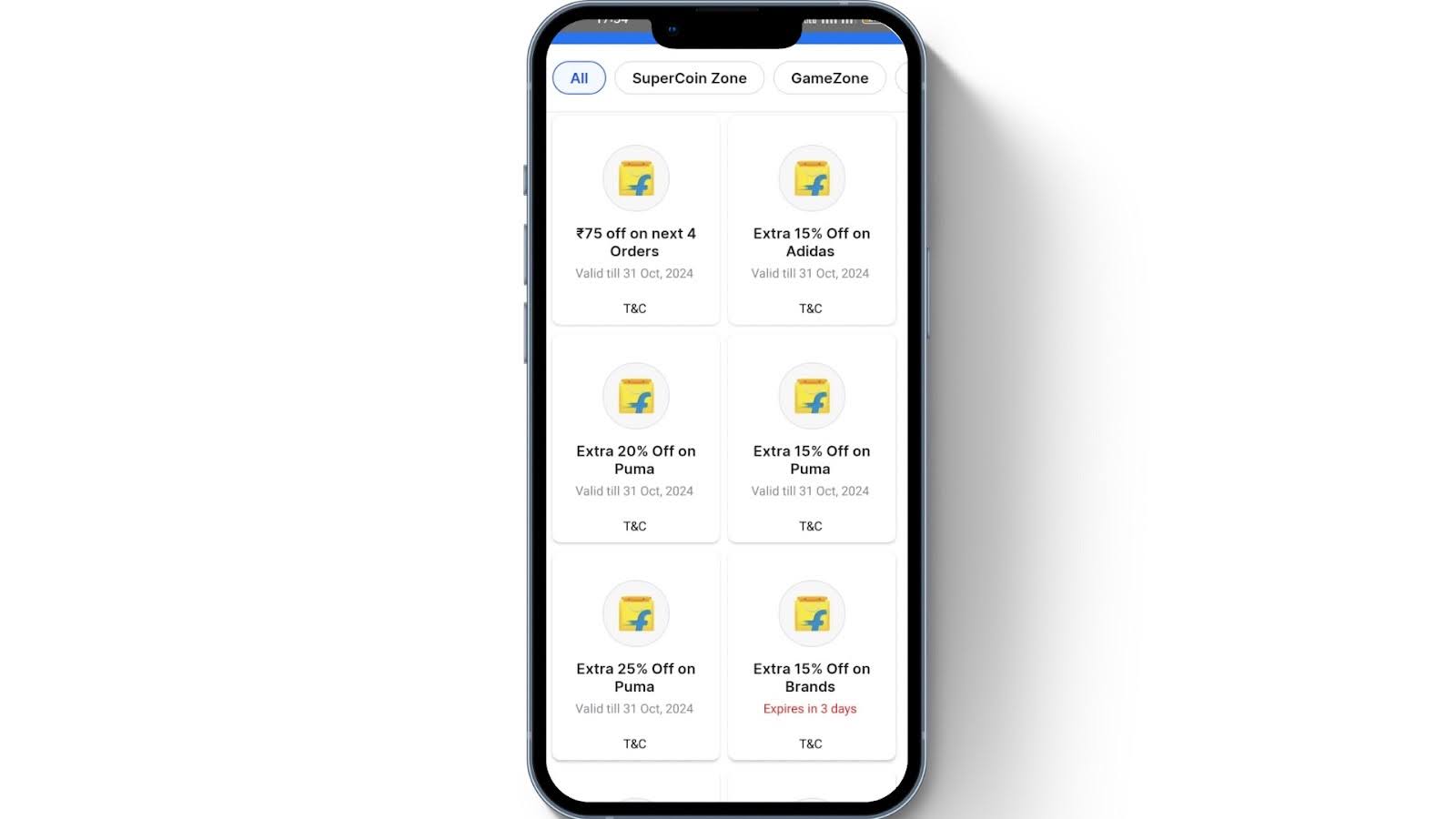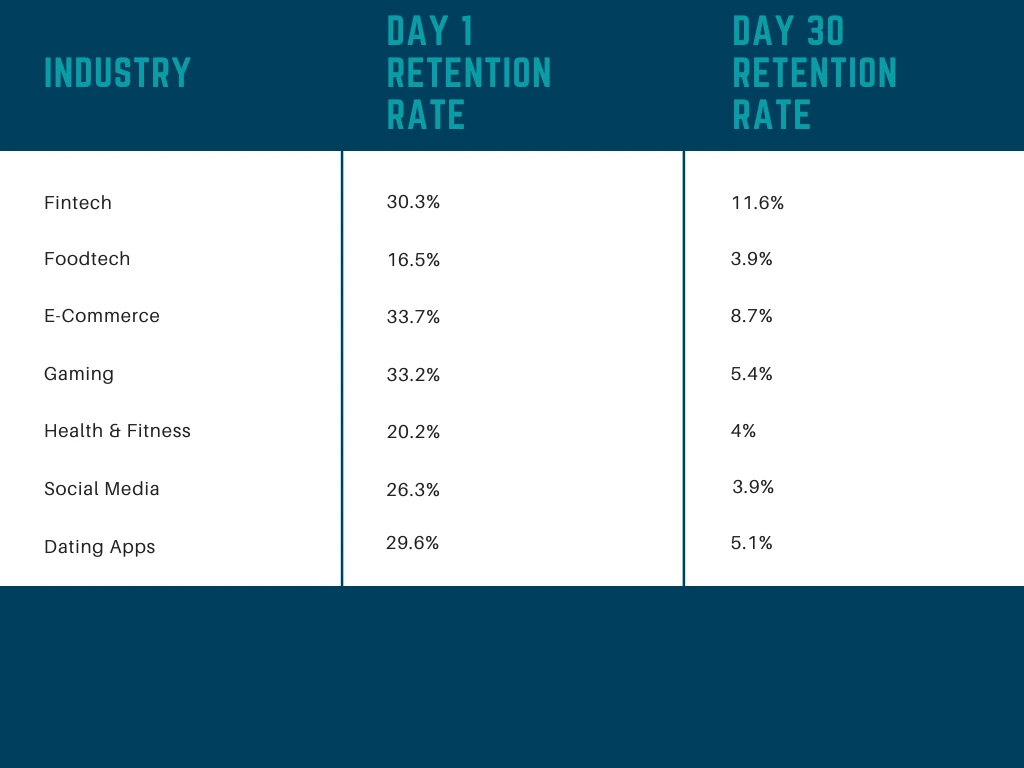We use cookies to ensure you get the best experience on our website. For more details, refer to our cookie policy and privacy policy.
November 19, 2025
5
minutes
Top Mobile App Monetization Strategies in 2025
Discover the most effective mobile app monetization strategies for 2025. Learn proven tactics to boost your B2C app's revenue through in-app messages.

Aarzu Kedia
.jpg)
Mobile app monetization is the process of generating revenue from your mobile application through strategies like in-app advertising, subscriptions, in-app purchases, and hybrid models. With the mobile app market projected to surpass $600 billion by 2030 and users spending an average of $285,000 per minute on apps in 2024, effective monetization has become essential for sustainable app growth.
TL;DR:
- Over 95% of apps on both Apple App Store and Google Play are free to download, making post-install monetization essential
- Apps using hybrid monetization strategies (ads + IAP + subscriptions) represent over 60% of top-grossing apps
- In-app advertising spending is projected to reach $390 billion worldwide by 2025
- Apps with subscription models have 4.6x higher ARPU compared to ad-only monetized apps
- Successful monetization requires balancing multiple revenue streams while maintaining excellent user experience
What is mobile app monetization?
Mobile app monetization refers to the various methods and strategies employed by app developers to generate revenue from their mobile applications—essentially, it's how an app makes money. When users download and engage with your app, you convert their activity into income through ads, purchases, subscriptions, or strategic partnerships.
The dramatic shift from paid to free apps over the past 15 years has transformed app monetization into a crucial consideration. In 2009, approximately 77% of apps in the iOS App Store required upfront payment, but today only 4.9% of iOS apps and 3.01% of Android apps are paid downloads. This transition has compelled developers to completely rethink their revenue generation strategies.
Why mobile app monetization is important?
The app economy is thriving, but success requires strategic monetization planning from day one.
The Market Opportunity:
- By 2025, 4.69 billion individuals globally will own smartphones—an increase of 440 million new users from 2024 alone
- Consumer spending in mobile apps is expected to exceed $270 billion by 2025
- The average revenue per user (ARPU) for mobile apps globally is $4.52
- 98% of mobile app revenue worldwide comes from free applications, showcasing the effectiveness of in-app purchases and advertising
Why It Matters for Your App
Without effective monetization, even the most innovative apps struggle to sustain development, support, and growth. Nearly 95% of all iOS apps and 97% of Android apps are free to download, making revenue generation after install not just a bonus but a requirement for running a sustainable business.
The Core Challenges of App Monetization
Making money from apps is rewarding but comes with real obstacles. Understanding these challenges helps you build a more resilient strategy.
User Experience vs. Revenue Balance
Modern users are adept at avoiding advertisements, people are trained to close ads without even noticing their content. If monetization feels intrusive, you risk app abandonment. Over 54% of users uninstall mobile apps due to disruptive ads, and exceeding three pop-ups per visit boosts churn by up to 46%.
Identifying High-Value Users
Not all users are equally profitable. Industry data suggests only around 5% of users make in-app purchases. Finding and engaging users willing to spend requires sophisticated segmentation and targeting.
Platform Fees and Restrictions
Apple and Google still charge commissions of up to 30% on in-app transactions, cutting significantly into developer profits. These fees make margin management critical.
User Retention Challenges
App retention data shows that retention drops to 21% after the first 24 hours, 7.5% by day 10, and just 1.89% after 90 days. 65% of uninstall events happen within the first 24 hours, frequently due to overwhelming prompts for paid features or confusing ad experiences.
Acquisition Costs Rising
After analyzing a year's worth of data, mobile app marketing agencies have found that there's a massive difference between how much you pay for a user who downloaded the app and one who became a paying user. iOS 14.5 and stricter privacy legislation have increased customer acquisition costs by 60% while conversion tracking accuracy has decreased significantly.
Limited Visibility Into Performance
Without comprehensive insights into how users interact with monetization features, optimizing user journeys and maximizing revenue becomes difficult. Manual workflow management leads to errors, inefficiencies, and suboptimal outcomes.
Top Mobile App Monetization Strategies for 2025
In-App Messages (Strategic Communication)
In-app messages emerge as a powerful strategy to tap into your existing user base. These messages highlight key monetization features using tooltips, spotlights, blinkers, and coachmarks to direct user attention.
How It Works: Real-time offers via in-app messages convert hesitant users into enthusiastic participants. They nurture user understanding, guiding casual users toward becoming loyal paying customers. You can re-engage users at monetization crossroads with instant coupon codes and compelling offers, significantly boosting conversion rates.
Best For: E-commerce apps, subscription services, apps with multiple premium features
Example:Tokopedia, a prominent e-commerce company in Indonesia, uses a floating action button to showcase deals while users browse the app, maintaining a seamless experience.
.gif)
In-App Advertising
In-app advertising remains one of the most effective app monetization strategies, with ad spending in this market projected to reach $390 billion worldwide by 2025, growing at a CAGR of 8.17% through 2029.
Available In-App Ad Formats:
Banner Ads: Static or animated ads delivered by ad servers in specific app locations, personalized based on user data.
Video Ads: Rewarded video ads show the highest engagement, with a 91% completion rate and 43% higher click-through than static banners. Display in-stream and out-stream video options.
Native Ads: Seamlessly integrate into your app's design, resembling regular content for a non-disruptive experience.
Interstitial Ads: Full-screen ads are 30 times more likely to drive app installs compared to traditional banner advertisements, with expected eCPM rising to over $12.50 in 2025.
Rewarded Ads: Users receive rewards (extra tries, in-game currency) for viewing, creating positive engagement.
Gamified Ads: Interactive mini-game ads that actively engage users.
Performance Data:
- In-app ads have been shown to perform up to 11.4 times better than banner ads on mobile websites
- Cost Per Install (CPI) averages $1.80 globally, with iOS CPIs at $2.52 and Android at $1.29
Best For: Apps with large user bases, gaming apps, content consumption apps
Example: Spotify uses modals to highlight premium offerings, a form of in-app advertising that converts free users into subscribers.

In-App Purchases (IAP)
The in-app purchase market is experiencing exponential growth, valued at $209.13 billion in 2024 and projected to reach $257.23 billion in 2025 (CAGR of 23%), with expectations to reach $657.18 billion by 2029 (CAGR of 26.4%).
Types of In-App Purchases:
Consumables: Temporary or limited purchases like extra lives, in-game currency, or power-ups that users buy repeatedly.
Non-Consumables: One-time purchases that permanently unlock features or content, like removing ads or accessing premium levels.
How to Implement Effectively:While you can introduce in-app purchases at any point, the smart approach is analyzing user behavior and strategically offering purchases when users need help throughout the app experience.
Performance Insight:In-app purchases bring about 48.2% of mobile app earnings, making them significantly popular among developers. However, only around 5% of users make in-app purchases, requiring a considerable user base for this model to work effectively.
Best For: Gaming apps, productivity tools, photo editing apps, fitness apps
Example:In Candy Crush Saga, modals display opportunities to buy gold bars for power-ups needed to complete difficult levels—perfectly timed to user need.

Freemium Model
The freemium model dominates today's app monetization landscape, providing apps free with a limited basic set of functions while offering advanced features for a fee ranging from $0.99 to hundreds of dollars for annual subscriptions.
How It Works: Offer core functionality free while reserving premium features for paying customers. Spotify demonstrates the power of this model with an impressive 46% conversion rate from free to paid users.
Success Factors:
- The free version should be functional enough to retain users while leaving a feeling of missing value. Best results come from scenarios where limitations are built into the depth of use rather than basic functionality.
- Free tier creates broad user acquisition
- Premium tier provides clear, compelling value
- Gradual feature discovery encourages upgrades
Best For: Productivity apps, creative tools, social platforms, fitness apps
Examples of Freemium Apps
- Spotify: Free tier with ads, premium tier for ad-free listening and offline access
- Dropbox: Basic storage free, expanded capacity and business features paid
- LinkedIn: Free networking, premium insights and search capabilities paid

Subscription-Based Model
Subscriptions create predictable, recurring revenue that grows app sustainability. Research shows the average one-year retention rate for annual mobile app subscriptions in 2023 was 28%, more than double that of monthly subscriptions at 12%.
How It Works: Users pay recurring fees (weekly, monthly, or yearly) to access ongoing premium features or content. This model is especially beneficial for apps providing ongoing value, such as news, productivity tools, or entertainment platforms, as it fosters loyalty among users who appreciate continuous enhancements.
Revenue Impact:Apps using subscription models have 4.6x higher ARPU (average revenue per user) compared to ad-only monetized apps.
Best For: Content apps, productivity tools, fitness apps, streaming services, professional tools
Examples of Subscription-Based Apps:
- Amazon Prime: Bundled benefits including shipping, streaming, and exclusive deals
- Disney+: Content library access with regular new additions
- Headspace: Meditation and wellness content with new sessions added regularly
- Notion: Productivity features with ongoing collaboration tools

Paid App Model
While 95.1% of iOS apps and 96.9% of Android apps were free as of March 2024, paid apps still work for highly specialized applications where value is obvious before downloading.
When It Works: Users pay upfront before downloading. This model requires unique functionality, strong brand reputation, and clear value proposition.
Considerations: People love apps they use but would feel differently if asked to pay for them. Creating an app users are willing to pay for is a real challenge. You'll face steep competition with freemium alternatives.
Best For: Professional tools, specialized utilities, established brands with loyal followings
Example: Procreate, an iOS digital painting app, charges $12.99 per download successfully because it offers unique value that justifies the cost.

Cashback & Loyalty models
Offering cashback for premium purchases creates long-term stickiness. Users receive a portion of their spending back as store credit or points usable only for future purchases within your app.
Why It Works: This creates a win-win situation where users return for more purchases, driving long-term engagement and increasing lifetime value.
Best For: Payment apps, e-commerce platforms, fintech apps
Examples: Major players like Paytm, Google Pay, PhonePe, Freecharge, and MobiKwik, Flipkart have successfully adopted this strategy to retain users and encourage repeat transactions.

Partnership & Affiliate models
Partnership Model: Partner with other companies to earn shared profits or commissions. Your app promotes or supports partner products/services, earning a percentage of revenue generated from your users.
Affiliate Marketing: Recommend products from other companies and earn commission when your users make purchases. This model is more common with B2C apps that revolve around product or service discovery.
Best For: Travel apps, shopping platforms, content recommendation apps
Example: Zepto launched a Pokémon-themed quiz in partnership with Oreo to turn engagement into monetization. Users had to correctly answer a quiz question (with up to five chances), unlocking the next quiz only after getting the previous one right to win rewards.The quiz was configured and laucnhed within days with Plotline's no-code games and rewards module.
.gif)
Free Trial to Paid Conversion
Offer premium features for a limited time, then require payment to continue. This model demonstrates full app capabilities, giving users experience with value before making purchase decisions.
Conversion Insight: Some sources suggest that purchase rates range between 0.5% and 2% with freemium monetization models.
Best For: Subscription services, productivity tools, professional software
Examples of free trial to paid conversion apps
- Headspace: 7-14 day trials of meditation content
- Spotify Premium: 1-3 month free trials
- Adobe Creative Cloud: Free trials of professional creative tools

White Labeling
Build your app technology then license it to other companies under their brand name. You earn through licensing fees while partners save development time and costs.
Examples:
- Mindbody: Fitness platform licensed to studios under their branding
- Shopify: E-commerce platform white-labeled for various businesses
Best For: Platform businesses, B2B tools, infrastructure apps
SMS and Email Marketing
While considered traditional, these channels still drive significant engagement when done thoughtfully.
SMS Marketing: Connect directly with users to extend discounts on purchases or subscriptions. Prioritize explicit user consent and carefully consider message length and timing.
Email Marketing: With the infrequency of email address changes, maintaining presence in customers' inboxes keeps your app top-of-mind. Sevio Consistent communication encourages active participation and improves retention.
Example: Uber uses email campaigns to nudge users back to their app whenever a transportation need might arise.
Best For: Transaction-based apps, service apps, apps with periodic use cases

Understanding Platform Differences: iOS vs Android
Although the Google Play Store demonstrates higher download rates, Apple's App Store consistently generates more revenue, largely due to iOS users' tendency toward higher spending.
Key Differences
Revenue Performance:
- Despite a smaller user base, iOS generates 2.5x more revenue per user than Android
- Revenue projections for 2025 show App Store reaching $185 billion versus Google Play at $85 billion
User Behavior:
- iOS users are more likely to adopt paid apps compared to Android users
- Android has broader global reach, particularly in emerging markets
- Android holds 69.6% of the global OS market share, with iOS at 29.9%
Monetization Impact: Consider platform-specific strategies. iOS may justify higher pricing tiers, while Android benefits from volume-based ad monetization.
Critical Success Metrics for App Monetization
Tracking the right KPIs transforms guesswork into strategy. Here are the essential metrics every app should monitor:
Average Revenue Per User (ARPU)
ARPU measures the average revenue generated by each user. The global average is $4.52, calculated by dividing total revenue by monthly active users (MAU).
Calculation: ARPU = Total Revenue / Number of Active Users
Why It Matters: Shows how effectively you're monetizing your user base. Subscription apps tend to have significantly higher ARPU than other revenue models.
Lifetime Value (LTV)
LTV stands for "lifetime value" of an app user, showing how much each user is worth over the course of the time they'll use your app.
Critical Benchmark: If LTV is not higher than effective CPI (eCPI), your app costs more than it generates. A good benchmark is when users' average LTV is 2-3 times higher than eCPI.
Why It Matters: Determines how much you can afford to spend on user acquisition while remaining profitable.
Average Revenue Per Paying User (ARPPU)
Relevant for apps with in-app purchases. ARPPU shows how much monetary value one paying customer brings on average per month, quarter, or year.
Calculation: ARPPU = Revenue from IAP / Number of Paying Users
Cost Per Install (CPI) and Effective CPI (eCPI)
CPI is how much it costs to acquire a new user through paid channels. eCPI factors in viral growth by dividing CPI by your K factor (viral coefficient).
Target: Aim for around $1 for Play Store and $2 for App Store.
Retention Rate
Applications retaining 20% of daily active users after 30 days achieve up to 45% greater revenue compared to those with lower retention.
Industry Reality: Retention drops to 21% after the first 24 hours, 7.5% by day 10, and 1.89% after 90 days.

Conversion Rate
Percentage of users who complete desired actions (subscribe, purchase, etc.). Skipping early user feedback loops and pushing paywalls too aggressively leads to churn spikes of up to 50%.
Monthly Recurring Revenue (MRR)
Critical for subscription apps, MRR tracks how much revenue is generated each month, answering whether revenue growth is consistent or as planned.
Churn Rate
Studies show 74% of app users churn the day after install, usually due to frustrating design or confusing onboarding.
Common Mistakes to Avoid
1. Prioritizing Revenue Over User Experience
One of the most common mistakes is prioritizing revenue over user experience. Overloading an app with intrusive ads, pop-ups, or forced subscriptions frustrates users, leading to uninstalls and negative reviews.
Solution: User experience is crucial - intrusive and excessive advertising will be counterproductive to app monetization.
2. Relying on a Single Monetization Method
One mistake most app owners make is depending on one monetization model. Relying on one technique is too risky—if ad quality declines or users develop ad fatigue, your entire revenue stream suffers.
Solution: Implement hybrid strategies to diversify revenue streams and reduce dependency.
3. Monetizing Too Early or Too Late
Launching aggressive monetization before establishing a solid user base can backfire. Users generally want to explore the app and understand its value before encountering ads or paywalls.
Many startups assume that once users arrive, revenue will follow. The result is often a large audience that contributes little to actual revenue.
Solution: Gradual monetization works best. Start by introducing subtle methods like limited ads, time-based trials, or lightweight freemium features. As users grow familiar with the app's value, additional revenue streams can be added.
4. Ignoring Analytics and Data
Without real-time data, pivoting monetization strategies is delayed by at least 2-4 weeks.
Solution: Implement robust analytics from day one. Track user behavior, conversion points, and revenue patterns continuously.
5. Overlooking Platform Fees
In 2022, the mobile game market generated $110 billion from player spending, but approximately 30% ($35 billion) was consumed by platform fees.
Solution: Factor in 15-30% platform commissions when calculating profitability. Consider web monetization strategies to reduce these costs.
6. Ignoring Regional Differences
Ignoring local payment methods, language preferences, and cultural norms can limit adoption and revenue. Developers entering international markets need to adapt monetization models to local user behavior and expectations.
Solution: Localize pricing, payment options, and monetization strategies for different markets.
7. Poor Onboarding
Over 65% of uninstall events happen within the first 24 hours, frequently due to overwhelming prompts for paid features or confusing ad experiences.
Solution: Focus initial flows on product value, gradually introducing monetization only after core engagement milestones are achieved.
8. Not Complying with Privacy Regulations
Monetization involving data collection must comply with privacy laws like GDPR, CCPA, COPPA, and HIPAA where applicable. Failing to comply can lead to fines, loss of user trust, or app store removal.
Solution: Ensure transparent data collection policies, obtain proper consent, and stay compliant with all relevant regulations.
Best Practices for Successful App Monetization
Strategic Planning
✅ Choose Monetization Models Early: Setting up monetization models should be chosen before developing the mobile application, in tandem with considering user experience, user privacy, and developers' workflow.
✅ Understand Your Users Deeply: Match monetization strategies to user preferences, behaviors, and demographics. Generational nuances play a decisive role—younger people may prefer in-app purchases while older users may prefer subscription models.
✅ Research Your Competition: Detailed competitor research helps avoid recurring mistakes and improve methods. The chances of standing out in a strategy already effective against direct competitors are very high.
Implementation
✅ Keep Ads Balanced and Non-Intrusive: Find the right frequency and placement that maximizes revenue without disrupting user experience.
✅ Personalize Strategies for Segments: Different user groups respond to different monetization approaches. Segment and target accordingly.
✅ Clearly Communicate Value: Set transparent pricing structures before integrating in-app purchases or subscriptions. 70% of users abandon products with opaque or fluctuating price models.
✅ Optimize Payment Flows: Ensure payments are quick, simple, and secure. Support multiple payment methods including localized options.
Continuous Improvement
✅ Test, Analyze, and Iterate: Regularly A/B test monetization features, ad placements, and pricing strategies.
✅ Track Key Metrics: Monitor ARPU, LTV, retention rate, conversion rate, and churn consistently.
✅ Gather User Feedback: Listen to what users say about your monetization approach and adjust accordingly.
✅ Respect Privacy: Clearly explain data use and ensure compliance with regulations.
✅ Provide Excellent Support: Offer prompt, helpful customer support to build trust and reduce churn.
✅ Stay Updated: Keep pace with industry trends, platform policy changes, and emerging monetization technologies.
How Plotline Powers In-App Monetization for B2C Growth Teams
At Plotline, we understand that effective monetization starts with seamless communication. Growth and marketing teams need to move fast, test frequently, and optimize constantly - without waiting on development resources.
What Plotline Enables:
Zero-Code Implementation: Build and publish out-of-app and in-app messaging flows without writing a single line of code, saving your developers time for core product work.
Targeted User Engagement: Create in-app messages that match your design theme and deploy them to specific user cohorts based on behavior, lifecycle stage, or any custom criteria.
Monetization-Focused Messaging: Highlight premium features using tooltips, widgets, and video content that guide users toward conversion without disrupting their experience.
Real-Time Optimization: Deploy instant coupon codes, limited-time offers, rewards and personalized upsells at the perfect moment in the user journey.
Native Experience: All messaging components integrate seamlessly with your app's design system, maintaining brand consistency and user trust.
Book a demo to see how leading apps are showcasing their users native in-app experiences that drive measurable improvements in mobile app monetization and revenue metrics.
Sign up for our newsletter
Thank you! Your submission has been received!
Oops! Something went wrong while submitting the form.
Improve app adoption with Plotline
Join companies like Zepto, Meesho, Upstox and others that use Plotline to test and launch app experiences and boost activation, retention and monetization.
.png)


%201.svg)

%201.svg)
%201.svg)
.jpg)

.png)
.png)

